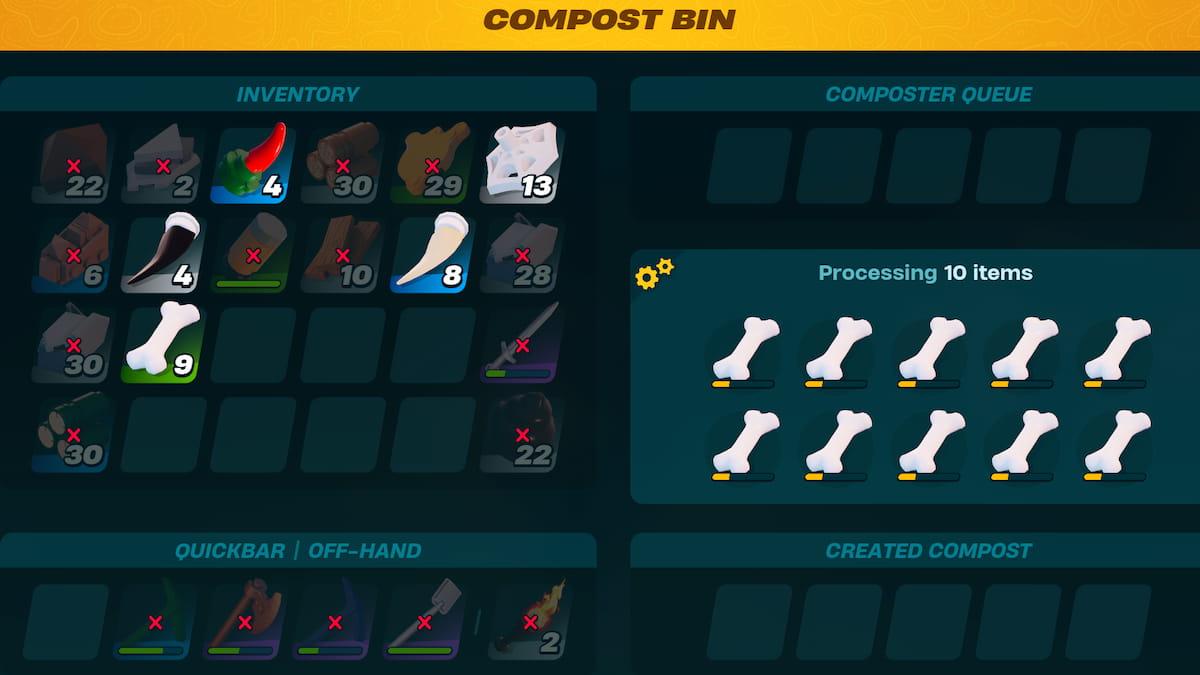In LEGO Fortnite, creating a power cell for cars requires obtaining dozens, potentially hundreds, of biomass. Making some is straightforward once you know what structures you need, but getting this much is another challenge. Here’s how to get biomass in LEGO Fortnite.
How to create Biomass in LEGO Fortnite
Making biomass in LEGO Fortnite requires building and breaking down items in a Compost Bin. Using food items and resources you collect from monsters, you’ll add them to your Compost Bin, wait for them to process, and obtain organic materials like soil, fertilizer, and biomass.

To begin, you must build your Compost Bin using the following materials:
- Plank x5
- Soil x2
- Sand x1
- Fertilizer x3
Once you build the bin, farm some hostile enemies or grow crops until you have food items and monster drops. My go-to item for the Compost Bin was bones, as you can easily find these by defeating skeletons at night. With your materials on hand, use them in the Composter Queue to begin processing. After a few minutes, your items will appear in the created compost section.

Depending on the items, you’ll obtain biomass, soil, or fertilizer. I reliably found all three by breaking down bones and other monster drops, but you can experiment with any organic materials you have on hand. Since composting takes time, getting extra soil and fertilizer from this can help you make more Compost Bins, which will hasten the process of obtaining biomass.
How to use Biomass in LEGO Fortnite
Biomass is a crucial resource for creating power cells, a fuel source for vehicles in LEGO Fortnite. Creating one power cell requires six glass and 50 biomass, making this an expensive recipe if you have multiple cars. You can make a power cell by visiting a crafting table and finding the recipe under the same category as torches and gliders.
Collecting biomass grants you the power cell recipe in your crafting bench. Once you visit your crafting table and find the power cell recipe, you can make it after gathering 50 biomass and glass. Obtaining glass requires collecting sand from the Dry Valley desert biome and shoveling the ground. After getting some sand, you’ll need a Metal Smelter and Brightcores to turn it into glass.
What do Power Cells do in LEGO Fortnite?
Using biomass to craft power cells is essential for powering vehicles. Once you craft your first power cell, you’ll unlock three vehicle recipes:
- Speeder
- Offroader
- Hauler
Each car has its crafting recipes, ranging from the Speeder’s early-game materials to the Hauler’s late-game requirements. To make a Speeder, you’ll need the following materials:
- Wooden Rod x18
- Cord x8
- Plank x2
- Wood x8
- Granite x9
The Offroader is slightly more challenging to build, requiring the following resources:
- Wooden Rod x20
- Cord x8
- Flexwood Rod x4
- Wood x34
- Glass x2
- Torch x2
- Plank x9
- Flexwood x16
- Granite x31
The Hauler is the most difficult to make of the three available vehicles, as you need materials from multiple biomes. Here is its crafting recipe:
- Wooden Rod x52
- Wood x102
- Frostpine x30
- Cord x8
- Frostpine Rod x6
- Granite x63
- Glass x2
- Torch x2
- Plank x10
- Flexwood x24
Regardless of the car you build, you’ll need power cells to fuel and drive them around, making it an important item. Be ready to create plenty of biomass, as vehicles drain your power cells over time, requiring you to check up on them and craft more as needed.













Published: Apr 3, 2024 01:55 pm